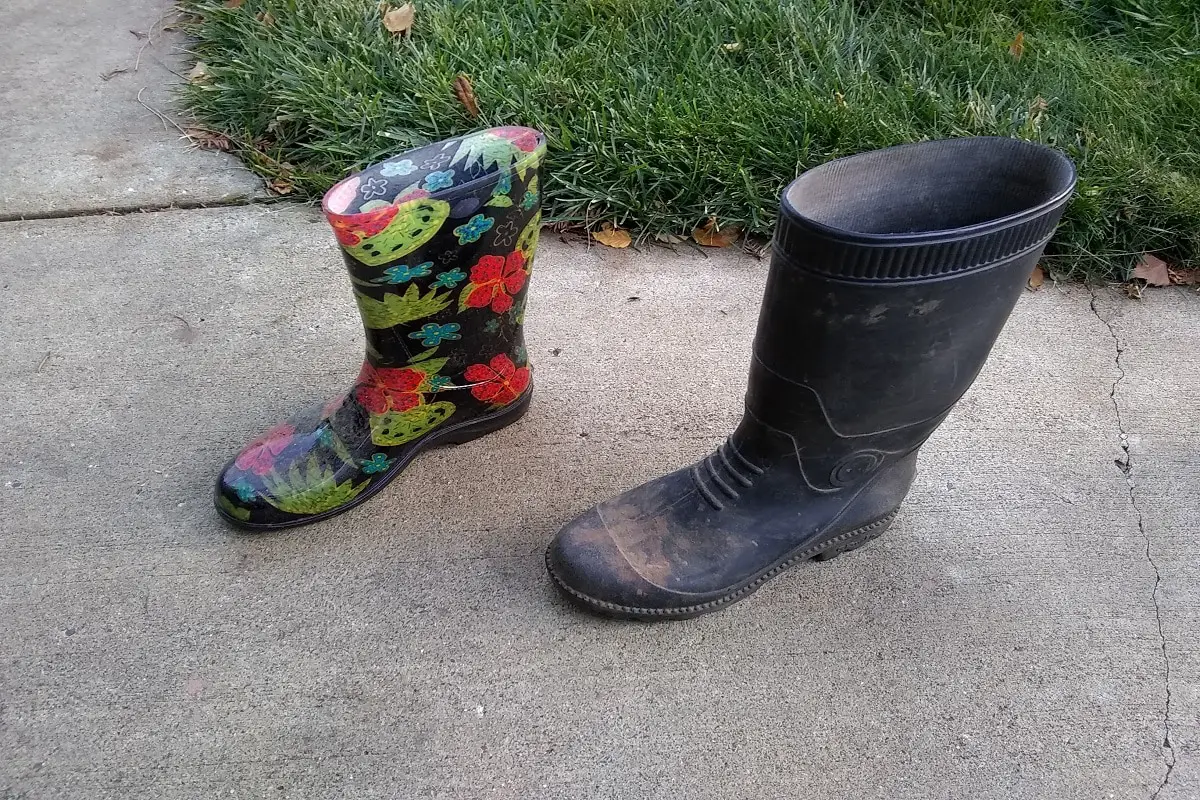If you wear rubber boots outside to do yardwork or brush clearing, you could find yourself bitten by an angry rattlesnake.
This is why it is important to make sure rubber boots are rattlesnake bite proof. Read on to find out if your rubber boots will protect you in this situation.
Rubber Boots – Rattlesnake Protection by Type
First, you need to evaluate what type of rubber boots you have. In order of least to most snake bite protection, here are the typical rubber boots most people own:
- Gardening Boots — these provide minimal, if any rattlesnake bite protection. They are made for flexibility and comfort while walking and kneeling in protected gardens.
- Rain boots (aka galoshes or wellies) — the typical soft silicon rubber rain boots, galoshes or wellies don’t provide much rattlesnake bite protection, although they are better than low top shoes
- All-purpose black or green rubber work boots (from the hardware or construction supply store) — these heavy duty rubber boots can provide significant rattlesnake bite protection. They have a harder, more durable outer shell meant for rough work conditions, and they go farther up the leg.
- Work Boots for light construction (usually made of rubber, leather, nylon or other additional materials) — depending on the design, these boots can provide moderate rattlesnake bite protection. The main problem is they typically don’t go up the leg far and are designed more for traction and ankle support on rough surfaces. They may have steel toes, which definitealy protect your toes from a mad rattler!

But before you head outdoors, see How to Avoid Snake Bites: 9 Foolproof Tips
Parts of a Rubber Boot Exposed to Rattlesnake Bites
The main parts of rubber boots include the:
- Sole: Typically made of heavy rubber and plastic, the sole provides good snake bite protection. It is unlikely that a rattlesnake will be able to penetrate the sole.
- Ankle: This is a weak point in most rubber boots from a rattlesnake protection standpoint. In order to get the rubber to flex at the ankle for comfort and mobility, manufacturers usually make this area thinner and use softer rubber.
- Toe: The toe area in most rubber work boots is pretty thick (not gardening or rain boots). Many rubber and mult-material construction boots have steel toes which cannot be penetrated at all by a rattlesnake’s fangs.
- Leg: Low-cut rubber boots like gardening boots and urban rain boots don’t provide enough protection from snake bites, which often strike higher up the leg. Your best bet is heavy duty green or black rubber work boots that go far up the leg. Most rubber boots have a large gap between your leg and the boot to enable mobility, ingress/egress and air circulation. This gap is an excellent rattlesnake bite defense, as the snake’s fangs won’t make it through the rubber, liner and 1/2 to 1 inch air gap. At least 13 inches of the ankle and lower leg region are covered in an all-purpose rubber work boot.

To increase your preparation for the risks of being outdoors in rattlesnake country check out What To Do If You’re Bitten by a Rattlesnake?
As an Amazon Associate, SelectSafety earns commissions from qualifying purchases made through links in this post.
Here are some highly-rated rubber boots if you’re looking to buy a pair:
DUNLOP Chesapeake Boots – 100% waterproof, lightweight and durable
HISEA Men’s Steel Toe Rubber Boots – excellent for work, gardening, fishing, outdoors
HISEA Women’s Knee-High Wellies Rain Boots – great for gardening, work, outdoors
Rubber Boot Materials and Thickness
Common unisex rubber boots are usually made of PVC rubber. Thickness may be 3 mm expanding to 4 mm for extra protection on areas such as the toe region. The midsole region may also include a rigid plastic construction.
More fashionable gardening boots may have less rubber thickness overall, such as 2mm or 3mm for the entire boot and no extra toe or ankle protection. These are designed mostly to keep the foot dry while working in wet dirt or mud.
Some rubber boots are made of proprietary material, such as Flexothane. This is a polyurethane coating over a knitted fabric making it highly tear-resistant. However, it is not designed to be puncture-resistant and cannot withstand a powerful snake bite.
Work Boots or Hiking Boots With Rubber Soles
Most work boots or hiking boots include a thick rubber sole that can protect them from any type of animal bite. The toes may also include added material and a steel toe.
However, the top part of the boot may be made of synthetic leather, nylon or thin rubber material that may not be thick enough to prevent a strong snake bite from penetrating.
Hiking or work boots may not be ideal for resisting snake bites but they are certainly better than wearing sneakers or flip-flops. Wearing additional thick wool socks underneath may add a bit of protection as well.
Are you going hiking with your kids? See Can Children Survive a Rattesnake Bite?
Weak Points on Rubber Boots
The metatarsal and ankle regions are the weakest points on rubber boots when it comes to rattlesnake bites. The arch is tight against the skin and allows no room between the rubber and the foot making it easier for a snake fang to reach the skin. The ankle is also exposed to a side strike by a snake and usually does not have added material for protection.
Rubber Boots vs. Snake Proof Boots
Rubber Boots Stop Body Heat From Emanating

Snakes respond to the body heat signature of the person or animal nearby, similar to other animals and insects. Snakes are active at night as well as the day and can spot body heat during this time period. Reading body heat allows snakes to not waste their venom on an animal that is not clearly alive and a threat.
Rubber boots do a fairly good job of keeping body heat from emanating. This allows them to go a long way in protecting the wearer from snake bites. Snake boots, however, are specifically designed to block the wearer’s heat signature and therefore are better suited for this purpose.
Bite Puncture Resistance
Snake boots are designed to prevent snake bites from puncturing and reaching the skin, so they are the ideal boot to wear in snake territory. With a pair of basic rubber boots, you could be in for a painful awakening. However, rubber construction boots are designed to stop punctures, and therefore provide a high level of snake bite protection.
Keep in mind that rattlesnakes strike and pull back usually. They don’t chew on your leg. A basic strike usually does not have enough power to pierce the rubber material. So, thicker rubber work boots are generally adequate for stopping rattlesnake bites.
Added Steel Toe
Some rubber boots include added toe strength with a steel toe insert. However, a steel toe can protect ONLY your toes from a rattlesnake bite.
Rubber Boots are Cheaper Than Snake Boots
Special snake boots can run into the hundreds of dollars, but general-purpose rubber boots can be in the low tens of dollars. You can also find cheap rubber boots almost anywhere they sell outdoor or gardening equipment. The idea is to go out with at least some protection from rattlesnake bites, and basic rubber boots can provide this.
Rubber Boots Provide SOME Protection From Rattlesnake Bites
If you do not have a good pair of snake boots, wearing a basic pair of rubber boots to garden or work in the brush is better than wearing tennis shoes or sandals. It’s alway best to keep a safe distance from rattlesnakes, but wearing rubber boots can provide you with some additional protection should you come too close.


